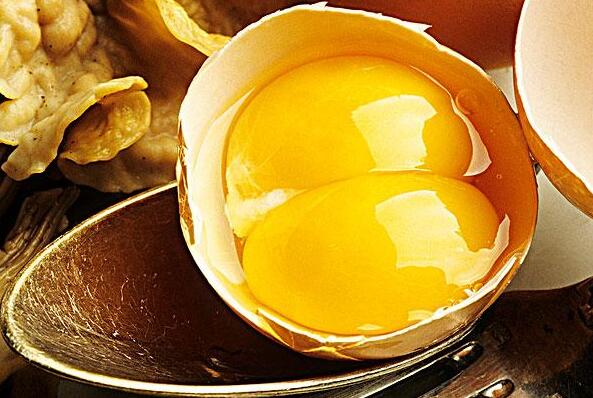The reason for the formation of double yolk eggs
Before talking about the formation of double-yolk eggs, let’s briefly talk about the formation of eggs.
When the hen reaches adulthood, the ovaries will produce egg yolk. After the yolk is produced, it enters the fallopian tube soon. There are many glands in the fallopian tube, and the arrival of the yolk will stimulate them to secrete protein. These egg whites wrap the yolk. After about 3 hours, the egg yolk is coated with a thick layer of egg white, and then it moves on and forms an eggshell membrane. The “prototype” of this egg enters the uterus. With the penetration of uterine fluid, the weight of the egg white increases, the shell membrane expands, and the egg takes shape. Then substances such as calcium carbonate are deposited on the eggshell membrane to form an eggshell, thus forming a complete egg. This process takes about 20 hours, then the egg enters the vagina, and after a short stay, the uterus contracts and is discharged from the body.
In a fully developed healthy hen, this production process is well coordinated-one egg yolk is produced every day, and a normal egg is produced. However, for those hens who are just beginning to lay eggs, the coordination of each part is not skilled enough, and “abnormal” may occur. For example, after a yolk is produced, the “control center” does not receive a signal, so another yolk is produced. Two yolks enter the fallopian tube, although it increases the burden on the follow-up departments, but these departments can still work normally after a little extra work. As a result, the two egg yolks are also wrapped and shaped by the egg white, and then excreted-the double yolk egg is thus produced.
The reason for the formation of soft shell eggs
In addition to producing two egg yolks a day, other abnormalities may occur in the “egg production line” of the hen, and other “strange” eggs may also be produced.
The “egg production process” of the hen is regulated by hormones. Abnormal secretion of hormones may produce double-yolk eggs. If the abnormality is severe, three or more yolks may be produced on the same day, and you will get “three yolks” or even more yolks. Although this is more rare than double yolk eggs, it is indeed recorded.
If the hen’s ovary is damaged and fragments appear, some of the fragments will be mistaken for egg yolk, so that the glands in the protein secretion department will work as usual, and the secretion of protein will wrap it up. A wrong step leads to a wrong step, and the subsequent processes follow the order, and finally an “egg” is formed. Such an egg has no yolk, and the ancients in some areas thought it was a “male egg”.
There is also a slightly more common anomaly than “male eggs”, “shellless eggs”. After the eggshell membrane is formed, if the deposition of the eggshell does not proceed, the egg can be laid out, and it becomes a shellless egg.
Does double-yolk eggs “affect development”?
Since the production of double-yolk eggs is caused by abnormal hormones, can the use of hormones make hens produce double-yolk eggs? Although double-yolk eggs may be produced by the natural growth of hens, double-yolk eggs on the market Will there be a “hormone egg”? This is also a concern for the mother in the introduction.
In theory, such a possibility cannot be ruled out, but in reality the possibility is very small.
“Illegal traders” do illegal business, always for “profit”, and “using hormones to produce double yolk eggs” can bring them illegal profits? On the one hand, double yolk eggs are not much more expensive than ordinary eggs, they are sold. Sometimes it is sold as a “big” egg. Although some places in the private sector regard the double-yellow egg as a symbol of auspiciousness, it cannot be judged before the break, and it is impossible to rely on the “double-yellow” to sell high prices. On the other hand, currently all countries in the world ban the use of hormones in chicken breeding, so there is neither research nor commercial production. Even if there is such a hormone, it must be “high price and low efficiency.” Using such hormones to produce double-yolk eggs is probably similar to “cannon hitting mosquitoes”, and the possibility of loss is greater than the possibility of profit.
In fact, even if someone really uses hormones to “grow” double-yolk eggs, the hormones affect the hens-hormones act as a signal, flicking the hens to produce an extra yolk. However, this does not mean that hormones will enter the eggs.
According to the composition analysis of double-yolk eggs and single-yolk eggs, there is no significant difference between the two. There are some in double-yolk eggs and also in single-yolk eggs; what is in single-yolk eggs is not bad in double-yolk eggs. Although the proportions of certain ingredients are slightly different, the difference is not big—at least for nutrition, the difference is completely negligible.
Nutrition composition of double yolk eggs
Egg white accounts for 28% of double yolk eggs, and egg yolks account for 72%. In a nutshell, most of the nutrients of an egg are concentrated in the yolk. The two yolks of a “double yolk” are the same size, so its nutritional value may be twice that of a single yolk.
ingredient
Egg white: mainly contains protein.
Egg yolk: mainly containing yolk phosphoprotein, lipid phosphoprotein, phospholipids, triglycerides, cholesterol; phosphorus, sulfur, calcium, chlorine, potassium, sodium, magnesium, iron; VA, VE, VB1, VB2, niacin, pyridoxine Acid, pantothenic acid, biotin, folic acid, VD; lutein, zeaxanthin, cryptoxanthin, etc.






